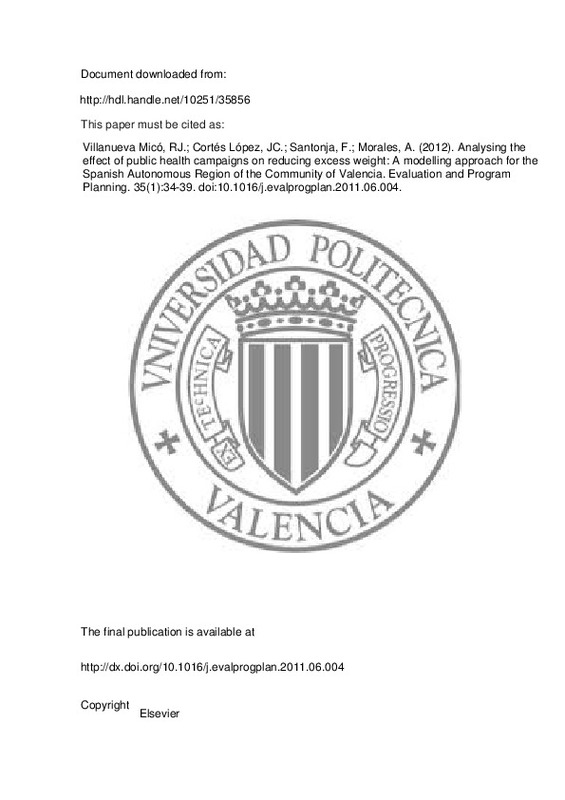JavaScript is disabled for your browser. Some features of this site may not work without it.
Buscar en RiuNet
Listar
Mi cuenta
Estadísticas
Ayuda RiuNet
Admin. UPV
Analysing the effect of public health campaigns on reducing excess weight: A modelling approach for the Spanish Autonomous Region of the Community of Valencia
Mostrar el registro sencillo del ítem
Ficheros en el ítem
| dc.contributor.author | Santonja, F.-J.
|
es_ES |
| dc.contributor.author | Morales, A.
|
es_ES |
| dc.contributor.author | Villanueva Micó, Rafael Jacinto
|
es_ES |
| dc.contributor.author | Cortés López, Juan Carlos
|
|
| dc.date.accessioned | 2014-02-21T09:25:12Z | |
| dc.date.issued | 2012-02 | |
| dc.identifier.issn | 0149-7189 | |
| dc.identifier.uri | http://hdl.handle.net/10251/35856 | |
| dc.description.abstract | Excess weight is fast becoming a serious health concern in the developed and developing world. The concern of the public health sector has lead to the development of public health campaigns, focusing on two-fold goals: to inform the public as to the health risks inherent in being overweight, and the benefits of a change in nutritional behaviour. Recent studies indicate that the effects of the average public health campaign on the target community is around 5%. In this study we aim to quantify the effect of different public health campaigns on lifestyle behaviour in the target populations in order to bring about weightloss in a significant number of people over the next few years. This study is based on recent works that consider excess weight as a consequence of the transmission of unhealthy lifestyles from one individual to another. Following this point of view, first a mathematical model is presented. Then, policies based on public health campaigns addressed to stop people gaining weight (prevention; this type of policy acts on individuals in order to maintain their weight and to stop an increase in weight) and, policies addressed to overweight individuals to reduce their weight (treatment; these campaigns act on overweight and/or obese individuals in order to reduce their weight) are simulated in order to evaluate their effectiveness. The study concludes that combination of preventive plus treatment campaigns are more effective than considering them separately. | es_ES |
| dc.language | Inglés | es_ES |
| dc.publisher | Elsevier | es_ES |
| dc.relation.ispartof | Evaluation and Program Planning | es_ES |
| dc.rights | Reserva de todos los derechos | es_ES |
| dc.subject | Excess weight | es_ES |
| dc.subject | Health communication campaigns | es_ES |
| dc.subject | Modelling | es_ES |
| dc.subject | Preventive policies | es_ES |
| dc.subject | Quantification | es_ES |
| dc.subject | Simulations | es_ES |
| dc.subject | Treatment policies | es_ES |
| dc.subject | Health policy | es_ES |
| dc.subject.classification | MATEMATICA APLICADA | es_ES |
| dc.title | Analysing the effect of public health campaigns on reducing excess weight: A modelling approach for the Spanish Autonomous Region of the Community of Valencia | es_ES |
| dc.type | Artículo | es_ES |
| dc.identifier.doi | 10.1016/j.evalprogplan.2011.06.004 | |
| dc.rights.accessRights | Abierto | es_ES |
| dc.contributor.affiliation | Universitat Politècnica de València. Departamento de Matemática Aplicada - Departament de Matemàtica Aplicada | es_ES |
| dc.description.bibliographicCitation | Santonja, F.; Morales, A.; Villanueva Micó, RJ.; Cortés López, JC. (2012). Analysing the effect of public health campaigns on reducing excess weight: A modelling approach for the Spanish Autonomous Region of the Community of Valencia. Evaluation and Program Planning. 35(1):34-39. doi:10.1016/j.evalprogplan.2011.06.004 | es_ES |
| dc.description.accrualMethod | S | es_ES |
| dc.relation.publisherversion | http://dx.doi.org/10.1016/j.evalprogplan.2011.06.004 | es_ES |
| dc.description.upvformatpinicio | 34 | es_ES |
| dc.description.upvformatpfin | 39 | es_ES |
| dc.type.version | info:eu-repo/semantics/publishedVersion | es_ES |
| dc.description.volume | 35 | es_ES |
| dc.description.issue | 1 | es_ES |
| dc.relation.senia | 206081 |







![[Cerrado]](/themes/UPV/images/candado.png)

